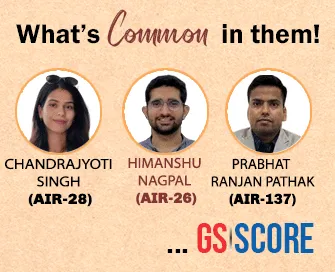

18th April 2025 (12 Topics)
Mains Issues
Context
Vice President Jagdeep Dhankhar recently criticised the Supreme Court for setting timelines for the President to grant assent to bills and described the Court’s use of Article 142 as a “nuclear missile against democratic forces.” These remarks revive the foundational debate on the doctrine of separation of powers enshrined in the Indian Constitution.
Legislature’s Perspective:
- Legislative Sovereignty: Parliament is the primary law-making body in a representative democracy. It derives its legitimacy from the people. The Vice President’s concerns reflect fears that judicial actions are intruding into the legislative domain, affecting democratic processes.
- Presidential Discretion and Executive Primacy: The legislature, through the Council of Ministers, advises the President. Article 74(1) mandates the President to act on this advice. Imposing judicial timelines on the President could be viewed as a restriction on executive functioning and an erosion of constitutional conventions.
- Accountability vs Overreach: Elected representatives are directly accountable to the people through elections. If judges dictate legislative or executive timelines, it can shift the balance of accountability. The legislature fears it will be answerable for decisions not entirely under its control.
Judiciary’s Perspective:
- Interpretation vs Legislation: While the judiciary cannot legislate, it has the power to interpret and enforce constitutional norms. In the Tamil Nadu case, it held that indefinite withholding of assent to bills violates the spirit of the Constitution — thus, it acted within its interpretative role.
- Use of Article 142: Article 142 empowers the Supreme Court to deliver justice where the letter of the law is silent or insufficient. In the absence of a fixed time limit for gubernatorial assent, the Court filled the constitutional vacuum to uphold federalism and legislative supremacy of elected assemblies.
- Judicial Independence: The judiciary’s role is to act as a check on potential executive or legislative excesses. It invokes constitutional morality to prevent misuse of authority, such as arbitrary delay in bill assent, which may undermine democratic processes in states ruled by opposition parties.
What is the ‘Core Issue’ (Inaction as Constitutional Evasion)?
- Constitutional Silence ? Inaction License: Articles 200 and 201 do not prescribe a timeline for the Governor or President to act on bills. However, indefinite silence effectively amounts to a pocket veto, violating democratic and federal principles.
- Federal Structure and Political Abuse: When a centrally appointed Governor stalls state bills, especially in opposition-ruled states, it raises serious questions on the misuse of constitutional positions. Judicial intervention seeks to protect states’ autonomy and the “will of the people.”
- Invisibility of Inaction: Unlike active decisions, delays leave no paper trail and are harder to challenge. Courts stepping in to counter inaction is not overreach but a constitutional necessity to prevent paralysis of democratic governance.
Fact Box: Separation of Power
Checks and Balances Mechanisms
|


Mains Issues
Context
The India Justice Report (IJR) 2025 has once again spotlighted the severe overcrowding in Indian prisons, the growing number of undertrial prisoners, and the persistent shortfalls in judicial, legal aid, and prison reforms. This is especially alarming as it comes amidst global scrutiny of India’s prison conditions, which has even impacted high-profile extradition cases.
Notably, two jails in Delhi's Tihar complex are operating at over 400% capacity, and across India, undertrials form 76% of the prison population, raising constitutional and human rights concerns.
Key Findings of the India Justice Report 2025 (IJR 2025)
- Overcrowding and Infrastructure Crisis
- 176 prisons have an occupancy rate of over 200%.
- 12 prisons are running at 400% capacity or more.
- Tihar Jail’s Central Jails 1 and 4 have occupancy rates of 411% and 467%, respectively.
- National average prison overcrowding stands at 131%.
- Only 68% of inmates have access to adequate sleeping space.
- Undertrial Crisis: Undertrial inmates form 76% of the total prison population — the highest ever. In Delhi, undertrials make up 91% of the jail population. In 6 states and UTs, more than half the inmates have been in jail for over 3 years. Trial pendency is highest in Bihar (71%), followed by West Bengal and Odisha.
- Legal Aid Gaps: 38% drop in paralegal volunteers since 2019. Despite new schemes like Legal Aid Defence Counsel (LADC) and jail clinics, resource allocation for community-based interventions is shrinking. Haryana showed the most improvement in legal aid delivery.
- Judicial Infrastructure and Human Resource Deficit: India has only 15 judges per million people (against the Law Commission's 1987 recommendation of 50). Vacancies in lower judiciary are a key factor in trial delays and undertrial incarceration.
- Budget Utilisation Paradox: Prison budget allocation increased by 156%, and budget for prisoners by 192% in the last decade. Per day expenditure per prisoner increased from Rs 62 to Rs 121. Despite this, fund utilisation is poor, and infrastructure has not kept pace with rising demand.
What Does the IJR 2025 Tell Us About Indian Prisons?
- Chronic Overcrowding, a Structural Problem: The persistent overcrowding of jails is not just a symptom of crime, but a failure of legal processes, administrative delays, and judicial vacancies. The absence of effective bail systems, and lack of fast-track courts for petty offences, exacerbates this.
- Undertrials: The fact that 3 out of every 4 inmates are undertrials — presumed innocent in law — reflects a grave miscarriage of justice. This raises ethical, legal, and constitutional questions, particularly under Article 21 (Right to Life and Liberty).
- Legal Aid Mechanism is Uneven and Underperforming: While initiatives like LADC systems and Lok Adalats are commendable, the erosion of paralegal and community legal networks shows a disconnect between policy vision and on-ground implementation.
- Poor Prison Conditions Affect Diplomacy and Human Rights Image: As noted by former SC judge Justice Lokur, India’s poor prison conditions are cited in foreign courts to block extraditions — this has serious implications for transnational justice and India's international credibility.
- Budget Increases Without Outcome-Focus is Futile: The near doubling of prisoner-related expenditure hasn't led to better living standards or rehabilitation programs. This points to poor planning, lack of monitoring, and absence of accountability in the prison administration system.
- Gender & Diversity Improvements Are Welcome but Not Sufficient: Progress like a rise in women in policing and judiciary (38%) is notable. But the absence of adequate infrastructure, such as women’s help desks in all stations, separate facilities in jails, or rehabilitation for marginalized groups, makes such progress fragile.


Mains Issues
Context
Union Commerce and Industry Minister Piyush Goyal’s recent remarks at the Startup Mahakumbh 2025 have reignited a national debate: Are Indian startups innovating enough or merely scaling convenience? By highlighting concerns that startups are focusing excessively on low-tech services like grocery and ice-cream delivery, the Minister underscored a deeper tension within India’s economic trajectory—whether its startup ecosystem is pushing the frontier of innovation or plateauing in market replication.
The state of Indian Startups
- India has earned its place as the 3rd largest startup hub globally, with over 100 unicorns shaping the future of innovation and entrepreneurship.
- Recognised as a powerhouse of entrepreneurial spirit, the country boasts of 157,066 startups acknowledged by the department for promotion of industry and internal trade (DPIIT) with more than 1.6 million jobs created.
- However, Indian startups for being too narrowly focused on low-tech, consumer-facing sectors like grocery and ice cream delivery, and not much focused on real ‘innovation’.
What counts as innovation?
- Innovation in the startup context is not monolithic. It can be categorized as:
- Incremental innovation (e.g., improving delivery logistics)
- Disruptive innovation (e.g., ride-sharing or fintech platforms)
- Deep-tech or science-led innovation (e.g., AI chips, quantum computing, 3D manufacturing)
- Piyush Goyal’s critique is implicitly aimed at the lack of deep-tech innovation—where startups serve as bridges between fundamental science and commercial application.
Why is Deep-Tech Innovation Scarce?
- High capital requirements
- Long gestation periods
- Absence of early revenue
- Need for skilled researchers and advanced infrastructure
- Lower risk appetite among Indian VCs and banks
- Despite over 1,65,000 startups, only a small fraction operate in robotics, clean energy, AI/ML, or advanced manufacturing. This is not for lack of ambition, but due to ecosystem constraints—a classic structural bottleneck.
Innovation and the Role of Capital:
- Domestic vs Foreign Capital Divide: India's startup ecosystem is primarily funded by foreign venture capital (VCs)—mostly from the U.S., Japan, and China. Domestic capital, especially risk capital from Indian investors or institutions, remains scarce. Piyush Goyal’s call for greater domestic investment points to a need for financial sovereignty and resilience.
- Short-Termism in Indian Capital: Indian capital tends to chase:
- Fast-scaling platforms
- Low-capex ventures
- Proven business models from the West
- This short-term orientation undermines experimental and patient capital, which is essential for building futuristic technology and global competitiveness.
- Structural Problem in VC Logic: Venture capital logic often requires:
- Scalability within 3-5 years
- Exit via acquisition or IPO
- Demonstrable market traction
- Deep tech doesn’t align neatly with this. Without IP-driven competitive advantage, investors will hesitate. Therefore, market failure in venture funding limits the types of innovation pursued.
Required Measures (Towards a Mature Innovation Ecosystem)
- Strategic Deep Tech Missions: There is need to lnk startups to national missions (clean energy, space, semiconductors).
- Reform Venture Funding Logic: Provide blended finance (government + VC) for patient capital in R&D.
- Encourage Indian LPs (Limited Partners): The government should incentivise Indian family offices, banks, pension funds to invest in VC.
- Decentralised Innovation Clusters: Build regional tech hubs linked with local universities.
- IP and Patent Ecosystem: There is need to strengthen India's IP infrastructure and expedite patent approvals.
- Regulatory Sandboxes: Let startups test products without full compliance during early stages.
- Enhance Corporate Governance: Cases like Byju’s show the need for stronger transparency and audit norms.
Fact Box: Comparison with China and the United StatesChina’s Model: Techno-Nationalism and Scale
India lacks such strategic clarity, though it aspires to technological self-reliance. U.S. Model: Risk-Tolerant Capitalism
India has parts of both models, but lacks the institutional cohesion and mission-driven orientation of either. |


Mains Issues
Context
In a significant development, a biotechnology firm in Texas (Colossal Biosciences), announced the birth of genetically modified wolf pups — claimed to be “resurrected” dire wolves, extinct for over 12,000 years.
What Has Been Achieved?
- Colossal Biosciences used genome editing to make gray wolves genetically resemble the extinct dire wolf:
- The gray wolf (Canis lupus) and the dire wolf (Aenocyon dirus) share 94% genetic similarity.
- The company edited 20 loci across 14 genes in the gray wolf genome, focusing on traits like size and fur — largely cosmetic traits.
- Embryos with edited DNA were implanted in dog surrogates, resulting in pups named Romulus and Remus.
- However, only a fraction (possibly 0.02%) of the actual genetic difference between the two species was altered. Crucially, behavioral, social, and ecological traits are shaped by the entire genome and environment — not just appearance.
- These are not true dire wolves, but genetically modified gray wolves engineered to look like
Why is De-Extinction Controversial?
- Ecological Risks: Habitats have changed drastically since these species went extinct. Climate, prey species, and ecosystems have evolved — reintroducing ancient species may cause unintended disruptions.
- Genetic Uncertainty: Partial genome editing can’t recreate the full complexity of extinct species. Behavioral traits, immunity, reproduction, and adaptability are unknown variables.
- Ethical and Regulatory Concerns: Animal welfare during gene editing and surrogacy is questionable. May divert attention and funding from protecting endangered species and conserving ecosystems.
- Policy Misuse: Colossal’s announcement was used to justify regulatory rollbacks in the U.S., as seen with the Trump-era rhetoric that "innovation, not regulation" would protect biodiversity.
Can Ancient Species Thrive in Today’s World?
- Conservation is shifting toward high-tech interventions. Conservation efforts should prioritize ecosystem resilience, biodiversity corridors, and habitat protection — not nostalgia-driven rewilding of prehistoric species.
- Ancient species evolved under specific environmental conditions — temperature, food sources, competitors — that no longer exist.
- Modern human-dominated landscapes may not support their reintroduction.
- Risk of becoming invasive species or failing to survive is high.
About Extinct Dire Wolf
De-Extinction
Genome Editing
|


Prelims Articles
Context
The Shrimad Bhagavad Gita and Bharat Muni’s Natyashastra have been inscribed in UNESCO’s Memory of the World Register — a global initiative that preserves documentary heritage of outstanding value.
The Bhagavad Gita
- Bhagavad Gita is a philosophical text consisting of 700 verses in 18 chapters, embedded in the Bhishmaparva (Chapters 23–40) of the Mahabharata.
- It is found in the sixth book of the world’s longest epic poem, the “Mahabharata,” the Gita was likely composed between the third century B.C.E. and the third century C.E.
- Written in Sanskrit, it is presented as a dialogue between Krishna and Arjuna on the battlefield of Kurukshetra.
- Global Significance: It is recognized as a spiritual-philosophical guide advocating:
- Nishkaam Karma (selfless action)
- Dharma (righteous duty)
- Detachment and inner balance
The Natyashastra by Bharat Muni
- Natyashastra is the earliest literature on music and drama – written somewhere around 500 BC by Bharata Muni.
- Comprising 6000 couplets in Sanskrit and spread over thirty-six chapters, Natyashastra’s focus was on dance and drama, with music as an aid.
- It is associated with N??yaveda, the sacred text of drama and performance.
- It categorically characterizes fundamentals such as Natya, Vithi, Bhav, Vyabhichari Bhav, Satvik Bhav, Vibhav, Anubhav, Rasa, Rasa Sutra, Nishpatti, Model Spectator, and highly spiritual concept of
- It is preserved at the Bhandarkar Oriental Research Institute, Pune.
- Core Concepts:
- N??ya (drama), Abhinaya (expression), Rasa (aesthetic essence), Bh?va (emotion), and Sang?ta (music).
- Introduces the
What is the Memory of the World Register?
|


Prelims Articles
Context
World Heritage Day is celebrated every year on 18th April to honor and protect cultural and natural heritage. This year theme is “Heritage under Threat from Disasters and Conflicts: Preparedness and Learning from 60 years of ICOMOS Actions.”
About
- World Heritage Day is celebrated every year on 18th April. It is also called the International Day for Monuments and Sites.
- The day is meant to honor and protect human heritage. It also appreciates the people and groups who work to preserve it.
- The day was started in 1982 by ICOMOS(International Council on Monuments and Sites).
- Later, in 1983, UNESCOofficially adopted it.
- Every year, ICOMOS gives a special theme for the day. Based on this theme, people and groups hold events and activities around the world to celebrate and protect heritage.
- World Heritage Convention: United Nations Educational, Scientific and Cultural Organization (UNESCO) works to protect and preserve important cultural and natural heritage around the world. To help with this, UNESCO’s member countries adopted the World Heritage Convention in 1972.
- World Heritage Sites: World Heritage Sites are special places on Earth that have great value for all of humanity. These can be cultural, natural, or a mix of both. They are protected under an international agreement led by UNESCO gives the World Heritage title to places that are culturally, historically or scientifically important.
- As of October 2024, there are 1,223 World Heritage Sites across 196 countries (952 cultural, 231 natural, 40 mixed).
- India has 43 World Heritage Sites, with Agra Fort, Taj Mahal, Ajanta, and Ellora Caves among the first listed in 1983.
Government’s Initiatives to Promote India’s Rich Cultural Heritage
|


Prelims Articles
Context
A new study by the National Institute of Advanced Studies (NIAS), Bengaluru recommends a rollback of the Environment Ministry’s 2015 mandate requiring all 537 coal-fired power plants in India to install Flue Gas Desulphurisation (FGD) systems.
What is FGD?
- Flue Gas Desulphurisation (FGD) is a pollution control technology that removes sulphur dioxide (SO?) from the exhaust flue gases of fossil-fuel power plants.
- It was mandated in 2015 to tackle India’s rising SO? emissions. The deadline for installation was 2018, but due to slow compliance, it has been extended to 2027–2029, depending on plant category.
- SO? contributes to acid rain, respiratory illnesses, and air pollution. FGDs were intended to curb these health and environmental risks.
What Does the NIAS Study Argue?
- FGD Not Needed at All Plants: 92% of Indian coal is low-sulphur (0.3%–0.5%). Thus, FGD should only be mandated for plants using imported/high-sulphur coal.
- Low Risk of Acid Rain in India: Acid rain is not a significant issue in India. Stack heights (minimum 220 m) and climatic conditions disperse SO? adequately.
- Environmental Trade-Off: Installing FGDs would:
- Increase CO? emissions by 69 million tonnes (2025–2030) due to higher energy and water use.
- Reduce SO? by 17 million tonnes — but this trade-off may worsen global warming.
- Focus on Particulate Matter (PM) Instead: PM pollution from coal plants is more harmful due to high ash content in Indian coal.
Fact Box: Sulphur dioxide (SO2)
|


Prelims Articles
Context
Scientists at the University of Cambridge, using data from NASA's James Webb Space Telescope (JWST), have detected potential biosignatures — molecules associated with life — in the atmosphere of exoplanet K2-18b, located 124 light years away. While not conclusive, this is the strongest signal yet in the search for extraterrestrial life.
What Did Scientists Detect?
- The James Webb Space Telescope (JWST) has detected traces of Dimethyl Sulphide (DMS) and Dimethyl Disulphide (DMDS) in the planet’s atmosphere.
- On Earth, DMS and DMDS are considered biosignatures — produced by simple life forms. If confirmed, this would be the first strong evidence of life beyond Earth.
- On Earth, these gases are only produced by living organisms, especially marine phytoplankton and bacteria.
- The detected quantity is thousands of times higher than levels on Earth—suggesting the possibility of abundant biological activity (if the source is life-related).
- How Was This Detected? Using infrared spectroscopy, JWST studied how the planet’s atmosphere absorbs starlight. This absorption pattern gives scientists clues about what chemicals are present in the atmosphere.
- Alternate Explanations: Gases could be produced through non-biological (abiotic) processes such as:
- Geological reactions.
- Molten oceans (not conducive to life).
- Mini gas giant structure with no solid surface.
What is K2-18b?
|


Prelims Articles
The Kerala State Electricity Board (KSEB) and IIT Bombay have launched a pilot project to explore V2G technology. The goal is to assess the feasibility of using electric vehicles (EVs) to support Kerala’s electricity grid, especially during peak demand hours.
What is V2G?
- Vehicle-to-Grid (V2G) refers to a system where electric vehicles (EVs) not only consume electricity but also send power back to the grid when needed.
- This is made possible through bi-directional chargers that allow EVs to both charge and discharge.
- Key Modes:
- G2V (Grid-to-Vehicle): EVs draw power from the grid to charge.
- V2G (Vehicle-to-Grid): EVs supply power back to the grid.
- Other variants:
- V2H (Vehicle-to-Home): Powers household appliances.
- V2V (Vehicle-to-Vehicle): Transfers charge between vehicles.
|
Global Applications:
|


Editorials
Context
The Supreme Court, in State of Tamil Nadu vs. Governor of Tamil Nadu (2025), held that the Governor’s prolonged inaction on state bills was unconstitutional. Using Article 142, the Court deemed the bills to have received assent, restoring federal balance but raising debates on constitutional accountability and judicial overreach.
Judicial Intervention and Constitutional Inaction
- Unequal Timelines – Contrasting Judicial Priorities: While the Supreme Court swiftly heard petitions against the Waqf (Amendment) Act 2025, it took five years to address the Governor's inaction on Tamil Nadu's pending bills from 2020.
- Federal Erosion – Impact of Governor’s Inaction: Failure to assent to state legislation undermines elected governments, dilutes legislative intent, and distorts the federal framework, especially when Centre and State are politically opposed.
- Legal Immunity – Challenges of Accountability: Governors enjoy constitutional immunity under Article 361; their inaction, being undocumented, often escapes judicial scrutiny, leaving states without legal recourse.
Article 142 and Judicial Remedy
- No Pocket Veto – Interpreting Articles 200 and 201: The Court clarified that the Constitution does not allow indefinite withholding of assent; inaction beyond a reasonable period violates constitutional responsibility.
- Extraordinary Remedy – Use of Article 142: Citing constitutional silence, the Supreme Court invoked Article 142 to do “complete justice,” deeming the bills assented, a first-of-its-kind intervention in legislative process.
- Rapid State Action – Tamil Nadu’s Response: Following the ruling, the Tamil Nadu government immediately notified the Acts, implementing the legislative intent delayed by the Governor's withholding of assent.
Accountability and Constitutional Implications
- Finding of Mala Fide – Governor’s Conduct Questioned: The Supreme Court held that the Governor acted without bona fides, disregarding Court directions and constitutional duties, severely breaching constitutional trust.
- Political vs Legal Accountability – Quo Warranto as Option: Though political calls for resignation have been made, legal accountability could be sought through a writ of quo warranto, challenging the Governor’s continuance.
- Subversion by Inaction – Growing Threat to Basic Structure: A trend of bypassing constitutional norms through inaction, rather than amendment, threatens constitutionalism and fuels calls to dismantle the Basic Structure doctrine and collegium system.
Practice Question:
Q. In light of the recent Supreme Court judgment in State of Tamil Nadu vs. Governor of Tamil Nadu, critically examine the constitutional position, powers, and accountability of Governors in India. How does judicial interpretation under Article 142 shape Centre-State relations?

Editorials
Context
An Olive Ridley turtle tagged as 03233, originally from Gahirmatha beach in Odisha, completed an extraordinary 4,500 km migratory journey to Guhagar beach in Maharashtra, leading to a successful nesting — a rare feat documented in turtle conservation history.
Conservation and Ecological Significance
- New Migration Pattern – Shift in Conservation Maps: Turtle 03233's route expands known Olive Ridley migratory corridors beyond Odisha's mass nesting sites, warranting updates in marine conservation zones.
- Cross-Coastal Ecology – India’s Marine Biodiversity: This journey, possibly circling Sri Lanka, underlines the need for integrated marine ecosystem policies across eastern and western coasts.
- First-of-its-Kind Record – Scientific Breakthrough: If confirmed, this would be the first documented long-range migration among Olive Ridleys in the Indian Ocean, altering existing scientific assumptions.
Conservation Technology and Challenges
- Tagging Tools – Cost-effective Tracking Methods: Titanium and inconel flipper tags, while affordable, offer limited accuracy compared to GPS, highlighting the need for scalable yet precise tracking technologies.
- Data Gaps – Need for Research Infrastructure: The uncertainty in tracking underscores the need for long-term ecological monitoring systems and marine biodiversity data platforms.
- Policy Implication – Protection Beyond Arribada Zones: Conservation efforts must extend to less-known nesting beaches like Guhagar, ensuring decentralised protection of turtle habitats.
Symbolism and Environmental Ethos
- Endurance as Ecological Insight – Long-term Survival Strategies: The turtle’s solitary journey is a metaphor for resilience, reflecting species adaptation in unpredictable marine ecosystems.
- Shift from Mass to Individual – Conservation Philosophy: It challenges the focus on mass nesting events, urging attention to individual ecological stories and decentralized conservation models.
- Inspirational Value – Public Awareness and Stewardship: 03233’s journey offers a compelling narrative to engage citizens in marine conservation, bridging science and emotional resonance.
Practice Question:
Q. The migratory journey of Olive Ridley Turtle 03233 from Odisha to Maharashtra has significant ecological, conservation, and policy implications. Examine the importance of migratory species in shaping marine conservation strategies in India. Suggest ways to strengthen coastal biodiversity monitoring.

Editorials
Context
A paper co-authored by a Cambridge scientist suggested the presence of possible biosignatures like dimethyl sulphide (DMS) in the atmosphere of exoplanet K2-18b, raising cautious optimism about the possibility of life beyond Earth. The news made headlines but also highlighted issues of scientific uncertainty, media hype, and political threats to curiosity-driven research.
Scientific Discovery and Analysis
- Exoplanet of Interest – K2-18b: Astronomers have long been interested in K2-18b due to its unique surface physiochemistry and habitable zone location around a red dwarf star.
- Detected Compounds – Possible Biosignature: Researchers detected dimethyl sulphide or dimethyl disulphide in K2-18b’s atmosphere; on Earth, DMS is primarily produced by biological processes.
- Scientific Temper – Need for Caution: Authors and external experts urge cautious interpretation, emphasizing data refinement, replication, and the high probability of overturning in such studies.
Challenges in the Practice of Science
- Pattern of Overhype – Media vs Research: The paper’s conservative conclusions were overshadowed by sensational press headlines like “Strongest hints yet of biological activity,” distorting scientific discourse.
- Vulnerability to Misinformation: When curiosity-driven science is sensationalized or politicized, it becomes susceptible to public misinformation and ideological manipulation.
- Funding Threats – Undermining Free Inquiry: The politicization of scientific funding, especially in the U.S., affects global research agendas by selectively targeting institutions and subjects.
Political Interference in Scientific Funding
- Trump’s Policies – Financial Sanctions on Academia: The Trump administration linked university funding with curtailment of DEI (Diversity, Equity, Inclusion) programs and protest activities, threatening institutional autonomy.
- Budget Cuts – NASA and NOAA Impacted: The 2026 budget proposal includes a 27% cut to NOAA, major reductions to NASA’s Goddard Space Flight Center, and halving of its earth-science budget.
- Ideological Bias – Republican State Doctrine: The funding redirection aims to suppress scientific disciplines not aligning with conservative ideology, constraining exploration in space, climate, and life sciences.
Practice Question:
Q. Scientific exploration in the 21st century increasingly finds itself constrained by political and ideological forces. Critically examine the implications of such constraints on curiosity-driven research, with suitable examples from space science and climate studies.


